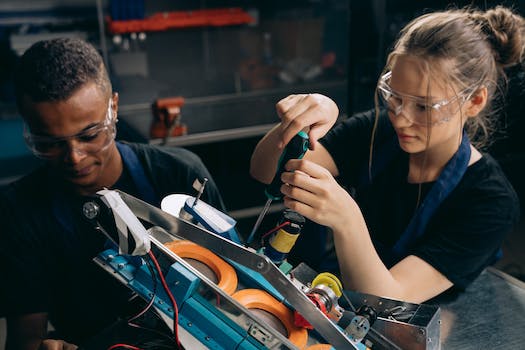-
Table of Contents
- Introduction
- How Robotics are Transforming the Manufacturing Industry
- The Benefits of Automation in Manufacturing
- The Challenges of Implementing Robotics in Manufacturing
- The Impact of Robotics on Job Creation in the Manufacturing Industry
- The Future of Robotics in Manufacturing: What to Expect
- Conclusion
“Unlock the Potential of Robotics: Transform Manufacturing with Automation!”
Introduction
The impact of robotics on the manufacturing industry has been profound. Robotics has revolutionized the way products are made, allowing for faster, more efficient production. Robotics has enabled manufacturers to reduce costs, increase productivity, and improve product quality. Robotics has also enabled manufacturers to reduce labor costs and increase safety in the workplace. In addition, robotics has enabled manufacturers to expand their product lines and enter new markets. This article will explore the impact of robotics on the manufacturing industry and discuss the potential benefits and challenges associated with its use.
How Robotics are Transforming the Manufacturing Industry

Robotics are revolutionizing the manufacturing industry, transforming the way products are made and how businesses operate. From automating mundane tasks to increasing production speed and accuracy, robotics are helping manufacturers stay competitive in an ever-evolving market.
Robots are being used to automate repetitive tasks, such as assembly, welding, and painting. This allows manufacturers to reduce labor costs and increase production speed. Automation also helps reduce errors and improve product quality. By using robots, manufacturers can produce products faster and with greater accuracy than ever before.
Robots are also being used to improve safety in the workplace. By automating dangerous tasks, such as welding and handling hazardous materials, robots can help reduce the risk of injury to workers. This can help manufacturers save money on insurance costs and reduce the number of workplace accidents.
Robots are also being used to improve efficiency in the manufacturing process. By using robots to monitor production processes, manufacturers can identify areas of inefficiency and make adjustments to improve efficiency. This can help reduce costs and increase profits.
Robots are also being used to improve customer service. By using robots to handle customer inquiries and orders, manufacturers can provide faster and more accurate service. This can help improve customer satisfaction and loyalty.
Robotics are transforming the manufacturing industry, making it more efficient, cost-effective, and safe. By automating mundane tasks, improving production speed and accuracy, and improving customer service, robots are helping manufacturers stay competitive in an ever-evolving market.
The Benefits of Automation in Manufacturing
Automation in manufacturing is becoming increasingly popular as businesses look for ways to increase efficiency and reduce costs. Automation can help streamline production processes, reduce labor costs, and improve product quality. Here are some of the key benefits of automation in manufacturing.
1. Increased Efficiency: Automation can help streamline production processes, allowing manufacturers to produce more products in less time. Automated systems can also help reduce errors and improve product quality.
2. Reduced Labor Costs: Automation can help reduce labor costs by eliminating the need for manual labor. Automated systems can also help reduce the need for additional staff, as they can handle tasks that would otherwise require multiple people.
3. Improved Product Quality: Automation can help improve product quality by reducing errors and ensuring that products are produced to the highest standards. Automated systems can also help reduce waste, as they can detect and correct errors before they become a problem.
4. Increased Safety: Automation can help reduce the risk of accidents in the workplace, as automated systems can be programmed to follow safety protocols. Automated systems can also help reduce the risk of human error, as they can detect and correct errors before they become a problem.
5. Increased Flexibility: Automation can help manufacturers quickly adapt to changing market conditions. Automated systems can be programmed to quickly adjust production processes to meet customer demands.
Automation in manufacturing can help businesses increase efficiency, reduce labor costs, improve product quality, and increase safety. Automation can also help businesses quickly adapt to changing market conditions. As businesses continue to look for ways to increase efficiency and reduce costs, automation is becoming an increasingly popular option.
The Challenges of Implementing Robotics in Manufacturing
Robotics is becoming increasingly popular in the manufacturing industry, as it offers a number of advantages over traditional methods of production. However, implementing robotics in manufacturing is not without its challenges. In this blog post, we’ll explore some of the key challenges associated with implementing robotics in manufacturing.
1. Cost: One of the biggest challenges associated with implementing robotics in manufacturing is the cost. Robotics systems are expensive to purchase and maintain, and they require a significant upfront investment. Additionally, the cost of training personnel to operate and maintain the robots can be high.
2. Complexity: Robotics systems are complex and require a high level of technical expertise to operate and maintain. This can be a challenge for manufacturers who lack the necessary expertise or resources to train personnel.
3. Safety: Safety is a major concern when it comes to implementing robotics in manufacturing. Robots can be dangerous if not properly programmed and monitored, and they can cause serious injury or even death if not handled correctly.
4. Flexibility: Robotics systems are designed to perform specific tasks, and they are not always able to adapt to changing conditions or requirements. This can be a challenge for manufacturers who need to quickly adjust production processes to meet customer demands.
5. Integration: Integrating robotics systems into existing production processes can be a challenge. It requires careful planning and coordination to ensure that the robots are properly integrated and that they do not disrupt existing processes.
Despite these challenges, robotics is becoming increasingly popular in the manufacturing industry. With careful planning and implementation, manufacturers can reap the benefits of robotics while minimizing the risks.
The Impact of Robotics on Job Creation in the Manufacturing Industry
The manufacturing industry has been revolutionized by the introduction of robotics. Automation has allowed for increased efficiency and productivity, resulting in a decrease in labor costs and an increase in profits. However, there is a growing concern that robotics will lead to job losses in the manufacturing industry.
While it is true that robotics can replace some jobs, it is important to note that robotics can also create new jobs. Robotics can be used to automate mundane and repetitive tasks, freeing up workers to focus on more complex and creative tasks. This can lead to an increase in job opportunities in the manufacturing industry, as workers are needed to design, program, and maintain the robots.
Robotics can also lead to an increase in demand for skilled workers. As robots become more advanced, they require more sophisticated programming and maintenance. This means that workers with the right skills and knowledge will be in high demand.
Robotics can also lead to an increase in demand for workers in other industries. As robots become more advanced, they can be used to create products that were previously too complex or expensive to manufacture. This can lead to an increase in demand for workers in other industries, such as design, engineering, and marketing.
Finally, robotics can lead to an increase in demand for workers in the service industry. As robots become more advanced, they can be used to provide services that were previously too complex or expensive to provide. This can lead to an increase in demand for workers in the service industry, such as customer service representatives, technicians, and software developers.
Overall, robotics can have a positive impact on job creation in the manufacturing industry. While it is true that some jobs may be replaced by robots, it is also true that robotics can create new jobs and increase demand for skilled workers in other industries. As robotics become more advanced, the potential for job creation in the manufacturing industry will only increase.
The Future of Robotics in Manufacturing: What to Expect
Robotics has been a major part of the manufacturing industry for decades, and its impact is only growing. As technology advances, robots are becoming more sophisticated and capable of performing complex tasks with greater accuracy and efficiency. In the coming years, we can expect to see robotics play an even larger role in manufacturing, with robots taking on more complex tasks and becoming more integrated into the production process.
One of the most exciting developments in robotics is the emergence of collaborative robots, or “cobots”. These robots are designed to work alongside humans, allowing them to take on more complex tasks while freeing up human workers to focus on higher-value activities. Cobots are becoming increasingly popular in manufacturing, as they can be programmed to perform a variety of tasks with greater accuracy and speed than humans.
Another trend we can expect to see in the future of robotics is the development of artificial intelligence (AI). AI-powered robots are capable of learning from their environment and adapting to changing conditions. This allows them to take on more complex tasks and make decisions based on data and analytics. AI-powered robots can also be used to automate processes, reducing the need for human labor and increasing efficiency.
Finally, we can expect to see more robots being used in the manufacturing process. As robots become more sophisticated, they will be able to take on more complex tasks and become more integrated into the production process. This will allow manufacturers to increase their output and reduce costs, while also improving the quality of their products.
The future of robotics in manufacturing is an exciting one, and it’s clear that robots will continue to play an increasingly important role in the industry. As technology advances, robots will become more sophisticated and capable of performing more complex tasks with greater accuracy and efficiency. This will allow manufacturers to increase their output and reduce costs, while also improving the quality of their products.
Conclusion
The Impact of Robotics on the Manufacturing Industry has been immense. Robotics has enabled manufacturers to increase production efficiency, reduce costs, and improve product quality. It has also enabled manufacturers to reduce labor costs and increase safety in the workplace. Robotics has also enabled manufacturers to increase their competitive advantage by providing them with the ability to produce products faster and more accurately than ever before. As robotics technology continues to evolve, the impact of robotics on the manufacturing industry will only continue to grow.















